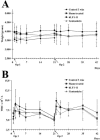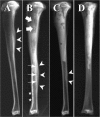Comparable efficacies of the antimicrobial peptide human lactoferrin 1-11 and gentamicin in a chronic methicillin-resistant Staphylococcus aureus osteomyelitis model
- PMID: 15917544
- PMCID: PMC1140484
- DOI: 10.1128/AAC.49.6.2438-2444.2005
Comparable efficacies of the antimicrobial peptide human lactoferrin 1-11 and gentamicin in a chronic methicillin-resistant Staphylococcus aureus osteomyelitis model
Abstract
The therapeutic efficacy of an antimicrobial peptide, human lactoferrin 1-11 (hLF1-11), was investigated in a model of chronic methicillin-resistant Staphylococcus aureus (MRSA) (gentamicin susceptible) osteomyelitis in rabbits. We incorporated 50 mg hLF1-11/g or 50 mg gentamicin/g cement powder into a calcium phosphate bone cement (Ca-P) and injected it into the debrided tibial cavity, creating a local drug delivery system. The efficacy of hLF1-11 and gentamicin was compared to that of a sham-treated control (plain bone cement) (n=6) and no treatment (infected only) (n=5). The results were evaluated by microbiology, radiology, and histology. MRSA was recovered from all tibias in both control groups (n=11). On the other hand, hLF1-11 and gentamicin significantly reduced the bacterial load. Furthermore, no growth of bacteria was detected in five out of eight and six out of eight specimens of the hLF1-11- and gentamicin-treated groups, respectively. These results were confirmed by a significant reduction of the histological disease severity score by hLF1-11 and gentamicin compared to both control groups. The hLF1-11-treated group also had a significantly lower radiological score compared to the gentamicin-treated group. This study demonstrates the efficacy of hLF1-11 incorporated into Ca-P bone cement as a possible therapeutic strategy for the treatment of osteomyelitis, showing efficacy comparable to that of gentamicin. Therefore, the results of this study warrant further preclinical investigations into the possibilities of using hLF1-11 for the treatment of osteomyelitis.
Figures







References
-
- Castro, C., E. Sanchez, A. Delgado, I. Soriano, P. Nunez, M. Baro, A. Perera, and C. Evora. 2003. Ciprofloxacin implants for bone infection. In vitro-in vivo characterization. J. Control. Release 93:341-354. - PubMed
-
- Craig, W. A. 1995. Once-daily versus multiple-daily dosing of aminoglycosides. J. Chemother. 7(Suppl. 2):47-52. - PubMed
-
- Hancock, R. E. 1997. Peptide antibiotics. Lancet 349:418-422. - PubMed
-
- Hill, J., L. Klenerman, S. Trustey, and R. Blowers. 1977. Diffusion of antibiotics from acrylic bone-cement in vitro. J. Bone Joint Surg. Br. 59:197-199. - PubMed
Publication types
MeSH terms
Substances
LinkOut - more resources
Full Text Sources
Medical
Miscellaneous

